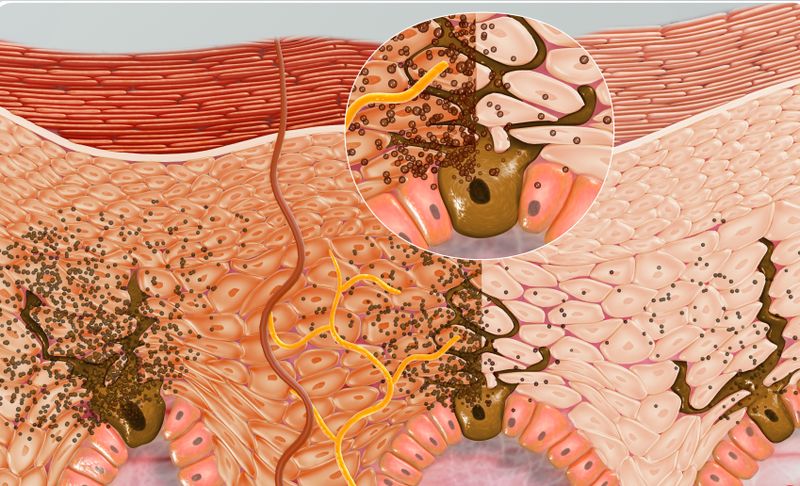Human beings are remarkable for their incredible diversity, and one of the most visually striking aspects of this diversity is the wide range of skin colors that people around the world possess. Skin color is a visible feature that has captivated our curiosity for centuries, prompting questions about its origins, significance, and underlying causes. While this topic has sparked numerous scientific investigations and discussions, the question at its core remains a simple yet profound one: Why do people have different skin colors?
The spectrum of skin tones we observe among individuals is a testament to the complexity of human biology and evolution. Skin color is a surface-level characteristic that is immediately noticeable, yet its roots extend deep into our genetic makeup and the history of our species. To understand why people have different skin colors, we must explore the intricate interplay of genetics, adaptation, and cultural influences that have shaped this aspect of human diversity.
People have different skin colors primarily due to variations in the amount and type of melanin, a pigment produced by melanocytes in the skin. Factors like genetics, sun exposure, and geographic location influence the level of melanin in an individual’s skin.
The Science Behind Skin Color

The Role of Melanin
Skin color is primarily determined by a natural pigment called melanin. Melanin is produced by specialized cells known as melanocytes, which are found in the epidermis, the outermost layer of the skin. Melanin serves as the body’s natural sunscreen, protecting the skin from the harmful effects of ultraviolet (UV) radiation from the sun.
- Types of Melanin
Melanin comes in two primary forms: eumelanin and pheomelanin. Eumelanin is responsible for brown to black pigmentation, while pheomelanin contributes to red and yellow pigmentation. The ratio and distribution of these two types of melanin in the skin, hair, and eyes determine an individual’s unique skin tone.
- Melanocytes and Their Function
Melanocytes, the melanin-producing cells, play a crucial role in determining skin color. These cells are evenly distributed throughout the epidermis. When exposed to UV radiation, melanocytes increase melanin production to protect the skin from UV damage. The more melanin present, the darker the skin appears.
Genetic Factors
While melanin is the primary determinant of skin color, genetics also play a significant role in defining an individual’s skin tone.
- Inheritance of Skin Color
Multiple genes play a role in the complex genetic trait of skin color inheritance. It follows a polygenic inheritance pattern, meaning that several genes contribute to the final skin color outcome. Individuals inherit variations of these genes from their parents, leading to a wide range of possible skin tones in a population.
- Genes and Variations
Specific genes control the production and distribution of melanin. Variations in these genes can lead to differences in melanin production, distribution, and types. Some genes increase melanin production, resulting in darker skin, while others may reduce melanin production, leading to lighter skin tones.
Understanding the science behind melanin production and the genetic factors influencing skin color provides valuable insights into the remarkable diversity of human skin tones. It’s essential to recognize that these variations are a natural part of human biology and have evolved as adaptations to different environments and levels of UV radiation exposure.
Melanin is a natural pigment responsible for the color of the skin, hair, and eyes. It is produced by melanocytes, specialized cells in the skin. There are two main types of melanin: eumelanin (brown/black) and pheomelanin (red/yellow).
Evolutionary Perspectives
Adaptation to Environmental Factors
The diverse range of human skin colors has evolved as an adaptation to environmental factors, primarily related to sunlight and climate.
- Sunlight and Vitamin D
Sunlight is a primary driver of the evolution of skin color. In regions with intense and consistent sunlight, populations tend to have darker skin. This adaptation protects against the harmful effects of UV radiation, including skin cancer and folate degradation. Additionally, it helps individuals in these regions maintain adequate levels of vitamin D, as darker skin reduces the skin’s ability to produce this essential nutrient in response to UV exposure.
- Protection Against UV Radiation
Darker skin contains higher levels of melanin, which acts as a natural shield against UV radiation. This adaptation aids in preventing DNA damage from excessive sun exposure. In contrast, populations in regions with less sunlight and weaker UV radiation tend to have lighter skin, allowing for more efficient vitamin D synthesis under limited sun exposure.
Geographic Distribution of Skin Tones
Human migration patterns have played a significant role in the geographic distribution of skin tones across the world.
- Examples of Regional Variation
Skin color varies significantly between populations from different geographic regions. For instance, people in equatorial regions near the equator, where sunlight is intense year-round, often have darker skin tones. In contrast, populations in higher latitudes, where sunlight is less intense and seasonal, tend to have lighter skin tones.
- Human Migration and Skin Color Changes
As humans migrated and adapted to new environments, changes in skin color occurred over generations. This gradual adaptation allowed populations to thrive in their specific environments. The distribution of skin tones today is a reflection of this complex history of human migration and adaptation.
Understanding the evolutionary aspects of skin color provides insights into how humans have adapted to diverse environments over time. It highlights the role of natural selection in shaping this characteristic to ensure the survival and well-being of different populations in varied climates and levels of sunlight exposure.
Skin color variations among different ethnic groups are primarily due to historical and geographic factors. Populations that evolved in regions with intense sunlight developed darker skin to provide protection against harmful UV radiation, while those in regions with less sun exposure developed lighter skin.
Cultural and Historical Significance
Skin Color in Cultural Context
Skin color has held cultural significance in societies around the world, influencing social norms, perceptions of beauty, and identity.
- Beauty Standards
Different cultures have established their own beauty standards, often favoring specific skin tones. These standards can vary widely, with some cultures valuing lighter skin and others favoring darker tones. Such standards can affect self-esteem and body image.
- Symbolism and Meanings
Skin color has been imbued with symbolism and meaning in various cultures. For example, in some cultures, lighter skin is associated with purity or nobility, while darker skin may symbolize strength or resilience. These cultural associations can impact how individuals are perceived and treated.
Historical Perspectives
Examining the historical context provides insights into how skin color has been viewed and treated over time.
- Skin Color in Ancient Societies
Ancient societies often had their own beliefs and perceptions regarding skin color. Some cultures attach spiritual or social significance to particular skin tones. These historical attitudes have influenced contemporary perceptions.
- Colonialism and Its Impact
The era of colonialism had a profound impact on the perception of skin color. European colonial powers often imposed their standards of beauty and superiority on colonized regions, leading to the stigmatization of local skin tones. This historical legacy continues to shape attitudes today.
While skin color can vary due to factors like sun exposure and age, a person’s underlying genetic predisposition largely determines their skin color. Long-term sun exposure can lead to tanning, but this is a temporary change in pigmentation.
Conclusion
In summary, the variation in human skin colors is fundamentally rooted in the intricate biological processes governing melanin production and genetic inheritance. These scientific mechanisms are the primary drivers behind the observed diversity in skin tones among different populations.
Skin color is a hereditary trait influenced by multiple genes and the types of melanin they regulate. Understanding the genetic basis of skin color provides valuable insights into how and why these variations occur within human populations.
Evolutionary forces, driven by the need for adaptation to varying levels of sunlight and UV radiation, have shaped the distribution of skin colors around the world. This adaptation has been a survival mechanism for populations exposed to different environmental conditions.
FAQs Why People Have Different Skin Colors?
How do genetics affect skin color?
Does skin color impact health?
How can people protect their skin from sun damage?
Can skin color change due to medical conditions?
What is the role of skin color in evolution?
References
- Featured Image: Black History Month – Institute of Health Policy, Management and Evaluation (utoronto.ca). Colorized.
- Jablonski, N. G., & Chaplin, G. (2017, May 22). The colours of humanity: the evolution of pigmentation in the human lineage. Philosophical Transactions of the Royal Society B: Biological Sciences. The Royal Society.
- How Europeans evolved white skin | Science | AAAS. sciencemag.org
- Jablonski, N. G. (2018). Evolution of Human Skin Color and Vitamin D. Vitamin D. Elsevier.
- Sturm, R. A. (2009). “Molecular genetics of human pigmentation diversity”. Human Molecular Genetics. 18 (R1): 9–17. doi:10.1093/hmg/ddp003. PMID 19297406.
